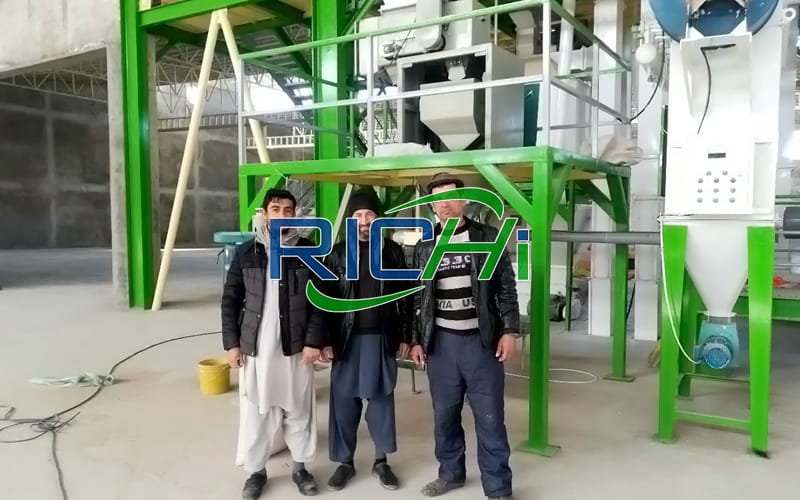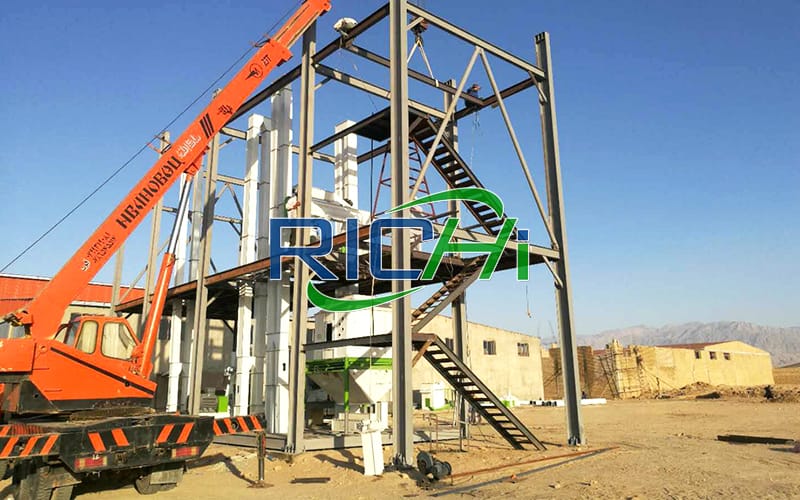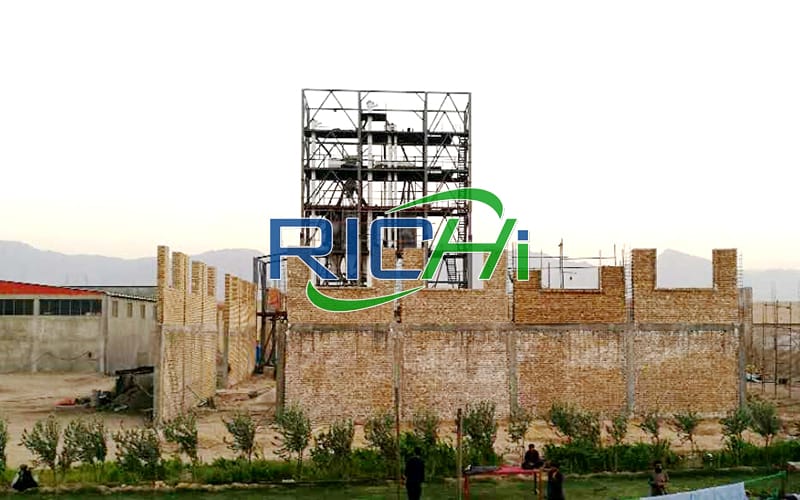
(1) Identification of the processing quality of animal pellet feed
The quality of animal pellet feed processing is mainly manifested in the following aspects:
① Stability of pellets. Mainly refers to the characteristic that the granular material maintains the original geometric shape during the cooling, classification, transportation and storage process after forming.
②The appearance quality of the pellets. Mainly refers to whether the surface of the pellets is smooth, whether the color and length of the pellets are consistent, etc.
③The hardness of the pellets. Feeding different animals has different requirements for the hardness of pellets. For example, the hardness of pig feed is lower, and the hardness of duck feed and fish feed is higher.
④The degree of granular maturation. The high degree of maturation of the pellets is conducive to animal digestion and absorption, which is often judged by detecting the gelatinization degree of starch.
⑤ The moisture of the pellets. Reasonable water content is conducive to improving the palatability of feed and the economic benefits of the enterprise; while lower water content is a necessary condition for safe feed storage.

(2) Factors affecting the quality of animal feed pellet manufacturing process
Among the influencing factors of animal feed pellet quality, the feed formula accounts for 40%, the crushing particle size accounts for 20%, the tempering effect accounts for 20%, the granulation process control accounts for 15%, and the cooling condition accounts for 5%. The empirical data we obtained in production practice basically accord with this view.
① The animal feed formula is an important factor to ensure the quality of the pellets. Among them, moisture, starch, protein, fat and crude fiber have a particularly significant impact on the quality of the feed pellets.
★The ideal moisture content of the comprehensive sample after mixing the raw materials is 12% to 14% in summer and 10% to 12% in winter. After the steam is absorbed by the quenched and tempered raw materials, the moisture reaches 15% to 17%. Generally, 1% of the weight of the raw material is added to the steam material corresponding to a temperature increase of 13-15°C. If the steam saturation is high, the moisture of the pellets will be 0.5% to 1.5% lower than that of the raw material after pelletizing and cooling in summer. If the conditioner and pellet cooler are not used in winter , Insulation moisture will rise by 0.5% to 1.5%.
As long as the steam saturation is sufficient, whether it is winter or summer to add more steam to make the material fully tempered, the moisture content of the material is lower than that of low-temperature tempering. Therefore, to control the moisture of the finished product, the moisture of the raw material must be controlled. Excessive water content in the raw material can also cause blockage of the ring die during the granulation process, resulting in sheet-like rice crackers mixed into the finished product, and even making continuous production impossible. If the moisture content of the raw materials is too low, the finished feed pellets are likely to be brittle, and the powdering rate will increase; at the same time, to improve the economic benefits of the enterprise and the palatability of animals, it is possible to manually add moisture conditionally, as detailed in the "conditioning effect" Clarify.
★The surface of raw starch is rough, the granulation resistance is large, and the bonding performance is poor. However, the starch will be partially gelatinized through steam conditioning and ring molding roller extrusion. Gelatinized starch has good binding properties and good granule quality. Therefore, sometimes a certain amount of starch raw materials should be added to the feed formula in order to meet the technological requirements but not the requirements of nutritional indicators.
This is especially important in the feed formula design of aquatic feed. For example, in the formula design of juvenile fish feed, the digestibility of starch by juvenile fish from the perspective of nutrition is extremely low, but in order to maintain the stability of juvenile fish feed in water, it must be added to the formula A certain amount of starch, or other binders. Different raw materials have different binding properties after gelatinization. For example, the bonding properties of barley and wheat are better than corn, and dried corn is not as good as natural air-dried corn.
★ When the protein content in the protein formula is appropriate, it is easy to granulate, and the granule quality is also good. Because the protein denatures and viscosity increases after heating, the output of the granulator is improved and the quality is good. When the protein content is too high, the ability to absorb steam is severely reduced, the tempering temperature is lowered, and the granulating effect is reduced.
★Fat: A proper amount of fat can reduce the frictional resistance between the material and the ring die, thereby reducing the wear of the ring die; it can also increase the output, reduce the energy consumption and smooth the surface of the particles. But if it is controlled within 3%, if the fat content is too high, the quality of the particles will decrease, and they are particularly brittle. If the fat content of the formula is more than 5%, the post spraying process can be used.
★Crude fiber: The content of crude fiber should not exceed 10%-15%. Because of its poor adhesiveness, the binding force between feed particles is reduced; at the same time, it also affects the ability of feed to absorb steam, which increases the hardness of the feed, reduces the forming rate and the output, and also seriously increases the amount of equipment wear and equipment vibration.
② The crushing particle size of raw materials The crushing fineness is an important link that affects the particle quality and production efficiency.
The fineness of crushing determines the surface area of feed components. The particle size is fine, the surface area is large, the moisture absorbed by the steam is uniform and fast, and the starch in the raw material has a high degree of gelatinization. The finer and more uniform the degree of pulverization, the better the quality of the produced particles, and the less wear of the ring die and pressure roller. On the contrary, crushed raw materials with coarse particle size contain large particles, which will cause the particles to be broken and broken, resulting in an increase in powder.
★ Conditioning effect
Conditioning is an important link before granulation. A good conditioning effect can greatly increase the output, reduce the vibration of the animal feed pellet making machine, reduce the energy consumption, and improve the quality of the pellets. The quality of the conditioning effect can be reflected by three indicators. One is the temperature of the raw materials after conditioning: Generally, the temperature of the raw material after conditioning is not less than 80°C; the aquatic feed is not less than 90°C; and the poultry feed is not less than 65°C.
The higher the conditioning temperature under the condition of not blocking the animal feed pellet manufacturing machine, the better it is to ensure the quality of the feed pellets, and the nutrients will be destroyed as little as possible. The second is moisture: usually the moisture content of compound feed can reach 15%-17% after conditioning. Different materials have different water absorption capacity; if the material has poor water absorption capacity, adding too much steam will easily cause machine blockage after being transformed into free water. The third is time: the material needs more than 30-40s in the quenching and tempering room.
The factors that affect the conditioning effect have three aspects: a. the characteristics of the material itself; b. the quality of the steam; c. the performance and parameter adjustment of the conditioning equipment.

③Ring die and animal feed granulator factors
The main factors affecting the quality of the pellet feed are the compression ratio of the ring die, the diameter of the hole, the roughness of the hole wall, the diameter and depth of the pressure relief hole, and the maintenance conditions. Different types of feed have different requirements for the compression ratio and die hole diameter of the ring die. To suppress different types of feed, the corresponding compression ratio and aperture must be selected to obtain feed pellets of the required quality. The maintenance and use of the ring die will also affect the quality of the pellet feed. If the following conditions occur, the pellet feed quality will be significantly reduced: uneven wear on the working surface of the ring die, excessive honeycomb holes, reduced effective thickness.
The main factor of the ring die animal poultry rabbit aqua fish shrimp feed pellet mill is the speed. The linear velocity of the ring die on the pelletizer is generally 4-8m/s (the linear velocity is measured on the outer diameter). The pelletizer that can provide two compression die speeds can achieve the best results when producing a wide range of feeds. Generally speaking, the higher the speed of the animal feed pelletizer equipment, the worse the quality of the feed pellets.
④ Cooling factor
The temperature of pellets leaving the ring die is 70℃~100℃, and the moisture content is 15%~18%. In order to store and transport safely, ensure the durability of pellets and reduce the breakage of pellets, the temperature of pellets should be lowered to no higher than room temperature. 5°C, preferably within 3°C. The water content is reduced to 10%-12.5%, and this process is completed by the feed pellet cooler. Generally, when the air temperature increases by about 11 ℃, its water holding capacity can be doubled. Therefore, when the moisture content of the semi-finished product is high, the moisture of the animal feed pellet product can be adjusted by increasing the temperature of the air entering the feed pellet cooling machine. At present, the countercurrent cooler is widely used in conjunction with the ring die type animal feed pelleting granulator. This pellet cooler has a high degree of automation. After the pellets are cooled, the surface and the inside are the same, no cracks, and smooth appearance.
Richi Machinery Animal Feed Pellet Making Plant Project Solutions And Layout Design
★1-100 ton per hour poultry animal feed processing plant
★1-100 ton per hour livestock pellet feed plant production
★1-100 ton hr ruminant feed plant with automatic coverage
★Turn-key premix feed mill factory
★1-100t/h advanced poultry chicken broiler animal feed pellet making plant
★1-100TPH animal feed manufacturing process machine of cattle feed plant


